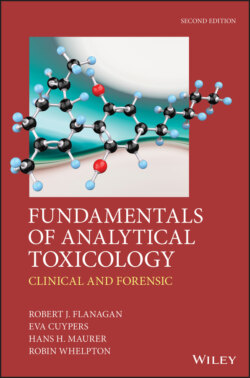Читать книгу Fundamentals of Analytical Toxicology - Robin Whelpton - Страница 25
1.3.2 Choice of analytical method
ОглавлениеIn responding to a given analytical problem, many factors must be considered. It may seem self-evident that the method used should be appropriate for the intended analysis. In practice, the choice of method depends on several factors. These include (i) the circumstances under which an analysis is requested (i.e. the question being asked), (ii) the speed with which the result is required, (iii) the sample to be analyzed, (iv) the nature of the analyte (if known), (v) the expected concentration of any analyte(s), (vi) the time available for the analysis, (vii) the apparatus available, (viii) the existence of a validated method in the laboratory, and (ix) the training and experience of the analyst.
The nature of the sample and the expected concentration of any analyte(s) are obvious influences on the choice of method. It may be possible to measure the concentration of a known substance in a relatively pure solution directly using a simple technique such as UV spectrophotometry. However, if the sample is a piece of post-mortem tissue such as liver then a wholly different approach will be required. Typically, a representative portion of the tissue will have to be homogenized and the analyte obtained in a relatively pure form by LLE, for example, of the homogenate at an appropriate pH. Further purification or extract concentration steps may be needed prior to instrumental analysis. In the case of organic poisons, this will usually be by a chromatographic method such as GC or LC because both qualitative and quantitative information can be obtained during the course of the analysis. The choice of instrument may influence the choice of sample preparation procedure, although this is not always the case.
For optically active (chiral) drugs (Table 1.4), the desired clinical activity resides predominantly in one enantiomer, the eutomer. The other enantiomer (the distomer) may be either pharmacologically inactive, or have different properties from its enantiomer, so administration of a racemate (a 50:50 mixture of enantiomers, Table 1.5) is the same as giving different compounds as far as the body is concerned. The supply of optically active compounds as pure enantiomers is sometimes indicated by the name used (dexamfetamine, dextropropoxyphene, escitalopram, levorphanol), but this does not always apply (hyoscine, morphine, physostigmine). Moreover, it is thought that some 50 % of currently used drugs are chiral, of which some 88 % are supplied as racemates, usually without any indication of the fact (Nguyen et al., 2006). Atropine is the approved name for (±)-hyoscyamine, for example.
With the exception of amfetamine (Section 22.4.21.1) and other misused drugs where the enantiomers have different actions such as dextromethorphan/levomethorphan (levorphanol) and perhaps escitalopram (Section 22.4.3), there are few clear indications for providing chiral methodology for routine analytical toxicology at present. In part this is because chiral analysis at the sensitivity required for the analysis of biological samples is difficult. It should be noted that not only is MS achiral, but also that positional isomers cannot be differentiated by MS unless either resolved chromatographically, or by differing fragmentation patterns. Nevertheless, chromatographic methods have made a major contribution to the development of pharmacology and therapeutics by providing methods to separate enantiomers on a preparative scale and on occasions in biological samples (Fortuna et al., 2014).
